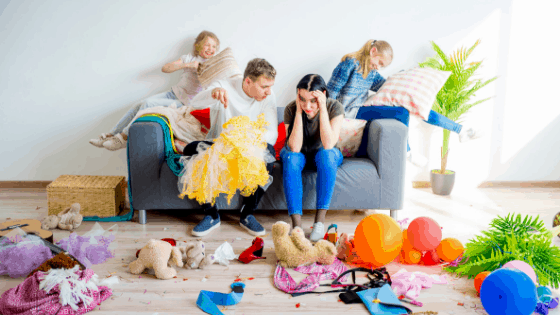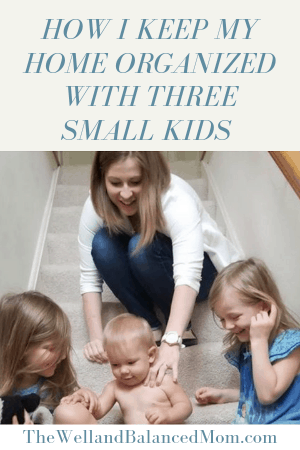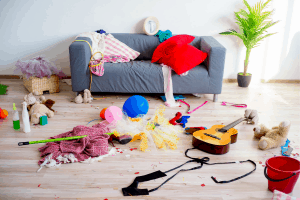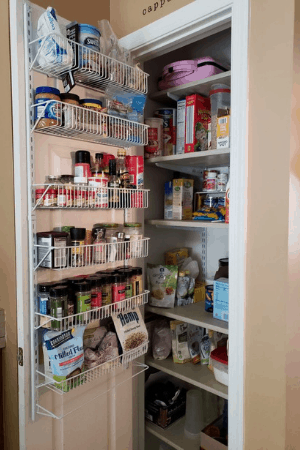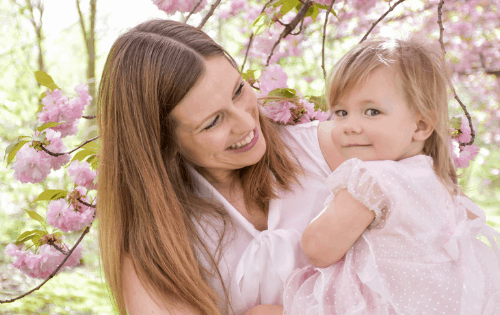Second of all, as I said in the title, I have three small kids (ages, 1, 4 and 6) who are on a constant mission to create chaos (sound familiar?).
So, how do I keep my home in order despite my natural lack of organizational skills and my kids’ natural ability to cause disorder and how can YOU do the same (no matter how you are starting out)?
This post contains affiliate links. If you make a purchase, I receive a small commission. You can read my full disclaimer here. Thank you for your support!
1. I get rid of all extra “stuff.”
My number one tip for anything about home life, cleaning, organizing, or tidying will always be to HAVE LESS STUFF.
If you are feeling overwhelmed about keeping your home organized, I recommend that your first goal is to purge out some of your excess belongings.
The fact is, most of us have way more “stuff” than we really need. It should be your goal to change that.
Think about it this way: Having less means less to do. Less to put away, to organize, to stress over. Having less means having more room to breathe, more space, more time to play with your kids.
How to Embrace “Having Less”

I once lived in a home that was small and cluttered. Drawers barely shut, every closet was bursting with clothes and shoes, and I had objects that sat in storage for years and years without being touched.
I kept things out of “necessity,” out of fear that I might someday need them, out of guilt, and out of plain old habit (I didn’t have a routine of discarding anything, so everything stayed).
Today, although I wouldn’t say that I’m a minimalist, at least not in the extreme sense, I live completely differently when it comes to “stuff.” The reason for the change is that I decided a few years ago that I would no longer be a slave to objects.
My mindset shifted started when I read Marie Kondo’s book, “The Life Changing Magic of Tidying Up.” Although I don’t agree with some of the more spiritual aspects of this book, I still highly recommend reading it, especially if you are in need of a mindset shift when it comes to discarding belongings.
For me, this book made me realize that “stuff” was taking up too much of my precious time and space. My extra stuff was a burden—and one that I was ready to let go.
So, one day I started the process of purging. I kept only what my family either…
A. Used regularly
or
B. Loved.
From then until today, if we don’t use something regularly or love it, it’s gone. It’s either trashed, recycled, or donated. If you have more patience than I do or if an object is valuable, you can also try selling.
Like I mentioned, I used to hold onto a lot of things purely out of guilt. If that’s you too, I’m sorry, but you will have to get over it. Again, you have to DECIDE that you will not let guilt determine how you live your life.
Don’t allow guilt about holding onto unnecessary objects be a reason that you are uncomfortable in your own home. Is guilt a good reason to lose family time because you’re stuck dealing with all the “stuff?”
You may have other mental blocks when it comes to discarding. (“What if I need this someday?” “But this is sentimental!” “I’ve had this forever, I can’t get rid of it now!”) Each one of these needs to be dealt with separately. If you can’t get your mindset right, there really is no point in starting at all. If you’re stuck, definitely consider reading Marie’s book that I mentioned earlier.
For me now, it doesn’t matter what it is, where it came from, or why we have it. I stick to my two questions (Does someone in the family love this? Does someone in the family use this?) and if I get two “No’s,” it doesn’t belong in our home.
But what about all the toys?!
If your home is like mine, the main clutter battle is with the toys.
I need to say that I don’t recommend discarding anything that isn’t yours without permission from the owner. It isn’t nice and can cause major conflicts, even if you know the object really should be gone.
That being said, only you can decide how to deal with your kids’ excess stuff. Depending on their ages and temperament, it may be appropriate for you to discard or donate toys that they won’t miss without asking them.
If you’re not sure if the toys will be missed or not, you can always try boxing them up and hiding them for a few months before donating them. If the kids don’t mention the missing toys, then you’ll feel better about giving them away. If they do mention them, then you can easily retrieve them.
I can’t get much by my kids, so I don’t usually attempt to get rid of their things without their permission. Instead, about once every three months, we go through their toys together and pick out what we can “give to other kids.”
This process is fun for us to do together and it amazes me how effortlessly generous they can be when given the opportunity.
If my girls decide they really want to keep something, I don’t push them about it. If they are on the fence about an item, I’ll ask them if they still like playing with it or if they played with it any time recently.
If the answer is no, then I’ll gently encourage them to give it away. If I get push back, then I let it go and return to the conversation on the next “purge” day.
Every time we go through this process, we come out of their playroom with at least one full bag of toys for donation (and there’s usually a few toys that go straight to the trash). Going through this purge cycle every three months or so keeps the house from being completely overrun.
Plus, at least in my home, there’s generally a bunch of new toys showing up every three months (birthdays, Christmas, random gifts from grandparents), so it is necessary to have a regular discarding routine if don’t want to look like we live at Toys R Us.
2. Everything has a place to go.
After you get rid of everything you don’t need, the next step is to make sure that everything you’ve kept has a place in your home. If it doesn’t have a place to go, where will it end up? The answer is: Anywhere and everywhere.
Once you have less stuff, it’s easier to assign a correct place for each item. You don’t need elaborate organizational systems in place when you have less (unless, of course, that’s your thing. In that case, go for it!)
I like to keep my systems simple. If I don’t, I never stick to them.
Books belong in the office, clothes in the closet, all paper-related material in a filing cabinet (not in a drawer, which is where the mail tries to end up), toys in a bin.
Since I have a 14-month-old, some toys do have spots on the floor in our living room, so that she can have easy access to them. Other than that, though, there is a basket for toys downstairs and once that is full, all the other toys in the house belong upstairs in my kids’ playroom. That system works well for us.
Inevitably, toys travel all over the house.
The toy kitchen ends up in the actual kitchen because the kids want to cook with me. Stuffed animals end up at the dining room table as guests at a tea party.
Once a day (usually after the kids go to bed), I try to get everything back to its proper place. Sometimes I do this more than once and sometimes I don’t do it at all. But the point is, everything has a place to go. And if it’s not being used by someone, it should be in its place, preferably right away (but at least hopefully by the end of each day).
Encourage the Kids to Pitch In
In addition to my efforts, I also encourage my kids to return things where they belong. I do this because I want them to learn to clean up after themselves, feel responsible for their own belongings, and be proud of the job they do keeping their space neat.
Does this mean their playroom is usually tidy? Um…no. Absolutely not.
They still require lots of extra “encouragement” to want to clean up. But I insist that when they do take the time to put things away, they have more room to play and they’re more likely to find what they want next time they go searching.
Eventually, I’m hoping that the desire to keep things in their place sticks, even if it takes until they’re 20. I have been delighted to see that some days they organize their toys without needing to be asked.
Even if it’s not how I would like it done (as it usually isn’t), I’m proud they are starting to show some initiative and hey, I’ll take whatever help I can get.
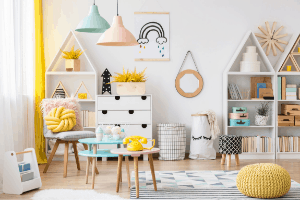
3. I focus on areas that are driving me crazy.
Recently, I started a new eating plan that forced me to try new recipes and cook at home more than I ever have in the past 8 years of adulthood. The extra cooking and new recipes meant that I needed to keep all kinds of different ingredients on hand. Suddenly, my pantry felt way too small. I was getting frustrated daily as I searched through spices and bags to find what I was looking for.
Every so often, for one reason or another, an area of the house starts to drive me crazy like this. Sometimes it’s the shoe closet, sometimes a random drawer. I address it as needed. In this case, the pantry became a priority. I did purge a few things out of it, but for the most part, I wanted to keep what was there, which meant I had some problem-solving to do.
Fortunately, we have this amazing thing called Amazon in our lives and I was able to find the solution to this problem fairly quickly. (See below)
If you have certain places in your home that drive you bonkers, take care of those areas as needed. If there’s a drawer that you can’t stand to look at, address it. Start by getting rid of what you don’t need, then decide if what’s left can be put someplace else.
4. I accept that a certain amount of chaos is NORMAL.
As much as I sometimes let my sanity be the reason for purging and organizing, I also realize that in order to fully preserve sanity, I need to let a few things go.
For example, my kids’ dresser drawers. I used to meticulously fold their clothes after doing the laundry, organizing the different pieces into neat little groups, and placing them perfectly in their respective places.
And then one day, the girls were big enough to pick their own outfits and very excited to do so.
Suddenly, the drawers that I spent time keeping tidy were a constant disheveled mess.
The only way I could keep them looking decent would’ve been to constantly rearrange and refold, and it would’ve probably involved lots of frustrated yelling.
I chose a different route– I gave up trying.
Now, all that I do is lightly fold their shirts and put them in one drawer, and then lightly fold the pants/shorts and put them in a different drawer. What happens after that, I’m not really concerned about.
Because who really cares anyway? Other than me, of course.
Literally, no one ever sees those drawers except for me and the kids and they obviously don’t care much if everything isn’t perfect. As long as the clothes are in the drawers and not on the floor, the girls know that I’ll be happy.
I don’t care what the drawers look like inside. It’s just not a battle I am choosing to fight at this time. It’s not important and it’s better for my sanity (and probably everyone else’s) to let it go.
We all go through different seasons of life. As much as I’d love to live in an HGTV-looking model home, my house is home to three small kids. It isn’t staged and its purpose isn’t just to look pretty.
Its purpose is to be a home. A home where there will be messes and fun and chaos and laughter, and three growing girls.
This beautiful and crazy season that I’m in right now doesn’t allow me to have a perfectly organized home. That’s just the way it is. If you’re a mom of small kids (or even not-so-small kids), the same is probably true for you.
When you stop worrying about perfection and give up on places in your home that aren’t worth the extra effort, it allows you to keep the more important areas looking neat. I’d much prefer that my living room and kitchen were presentable than my kids’ playroom.
I’m more concerned with drawers that I need to access every day than I am with theirs. See what I’m talking about here? Priorities. Prioritizing certain places prevents you from wanting to rip your hair out. The whole home can’t be a priority, or you may do just that (well, at least I would).
My point here is: Order in your home is good. Obsessing about perfection is not good. We all have to find the balance that’s right for us.
Summary
To recap and summarize, get rid of what you don’t need or don’t love, find a place for whatever you decide to keep, address areas of your house that you drive you crazy as you go, and accept that there will always be some chaos as long as your kids live at your house. If people want custom closet design, they can get them here! You can also have a peek at these guys if you need the best closet designs.
Someday, you’ll be able to keep your house as neat as you want it, and you just might miss the messes. Maybe, maybe not. For now, keep things as tidy as it takes to make you feel comfortable in your home, but not so neat that you’re constantly organizing when you should be living life.
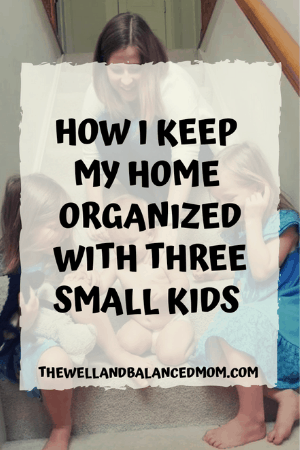
What tips do you have for keeping your home in order? Share in the comments below!
If you’re seeking more wellness and balance in your life, check out my FREE 5-day life coaching course “Finding Wellness and Balance as a Mom!” You can sign up here.
